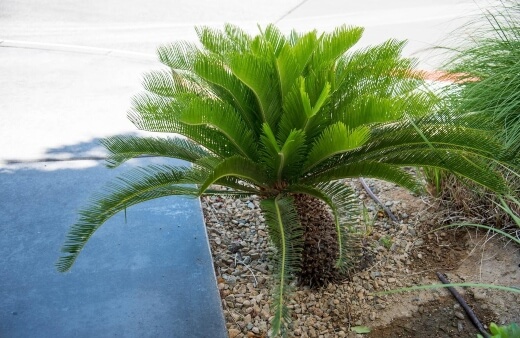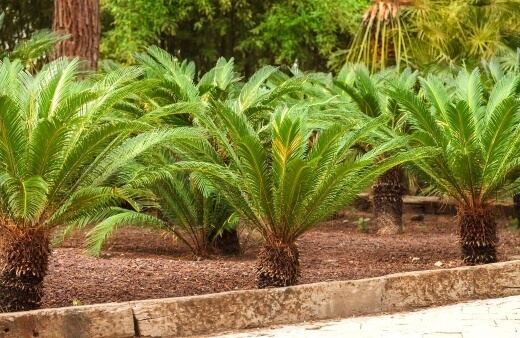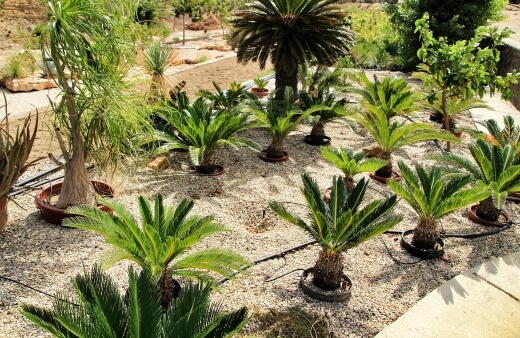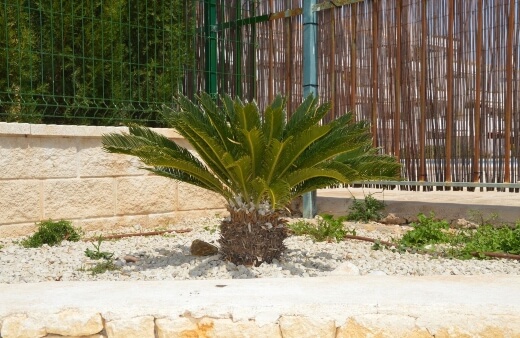Sago palms are a popular house and garden plant which are prized for their exciting and feathery foliage. Although considered a shrub, sago palms grow a lot like low growing trees and are an ideal option for indoor and outdoor growth.
This ornamental plant can grow in a range of environments and has a fairly easy-care routine. Are you interested in growing sago palm?
Here is everything you’ll need to know to have large, happy growing sago palms.
More...
What are Sago Palms?

Unlike the name suggests, sago palms aren’t actually true palms but instead a cycad – more closely related to evergreen conifers than palm trees. Yet it somehow picked up the common tag of being a palm and is rarely referred to as a cycad other than by those who know.
The difference: palms are monocotyledons (seeds sprout only one leaf) while cycads are dicotyledons (you guessed it…they sprout two leaves from the seed). Hardly a big difference when you’re trying to explain this plant’s genetic background.
Part of the Cycadaceae family, and perhaps the best known cycad species, these plants date back to prehistoric times and have quickly become a popular landscaping choice.
Sago palm, or Cycas revoluta, is an ornamental species native to Japan and Southern China. The sago palm produces large, feathery fronds which grow in a symmetrical ring around the thick stalk.
Although it is considered non-flowering, some cultivars in the right conditions tend to bloom every 3 years. For seed-grown varieties, flowering can take up to 15 years.
It is important to note that sago palms are mildly toxic to humans and pets when ingested. So, when grown indoors, it should be kept away from nosey pets and curious children.
How to Grow Sago Palms

Although it’s not an overly picky plant, sago palms do need the right kind of conditions to thrive. Sago palms can be grown both indoors and outdoors, provided with sufficient light and well-draining soil.
Although these plants enjoy some relative humidity, too much moisture will result in a very sad and drab plant. Grow your sago palm in loose, well-draining soil or a cactus-suitable potting mixture.
Sago palms enjoy bright, indirect light. This means they are ideally planted near a window or a sun-dappled spot in your garden. Take care. However, too much direct sunlight can lead to scorched leaves.
Whereas too little light can result in sparse growth. If growing indoors, pick a spot by east, west and south-facing window for ideal levels of light. You’ll always want to pick a spot away from heavy drafts or an AC.
In very dry regions or in hotter indoor spaces, it is advisable to give your sago palm some additional humidity by spraying it weekly with a spray bottle.


Get Your Free Guide:
Master Growing Australian Natives eBook
A Must Have Complete Guide for Every Australian Garden
Get Your Free Guide:
Master Growing Australian Natives eBook
A Must Have Complete Guide for Every Australian Garden
How to Propagate Sago Palms

Sago palms are usually propagated from seed. However, this can be an unsuccessful and timely process. This is why most people recommend propagation by means of division.
Healthy sago palms readily produce little pups from the main stalk, which can be removed and replanted to turn into new plants.
Pups should be removed from parent plants in spring or fall. Here is what you’ll need to do:
- Loose pups can be removed with a small tug. Pups that are harder to remove can be cut off the stalk with a sharp, sanitised blade or garden shears.
(Here is our review on the best garden secateurs available in Australia.) - Leave pups on a tray in a shaded arrow to allow it to dry out and callous. This will prevent the development of disease.
- In the meantime, fill a small pot with a porous potting mix.
- Place the pup into the centre of the pot, pressing it into the soil.
- Water well and leave in a sunny spot indoors.
Pups require a couple of months to begin to develop roots. Do not plant pups into the ground unless they have developed roots.
Growing Sago Palms From Seed
If growing from seed, it’s essential to get your seeds from a reputable source to ensure they germinate successfully. Seeds can also contain toxins, so when dealing with seeds, it is advised to use a pair of gloves.
Here is what you’ll need to do:
- Soak seeds in room temperature water overnight.
- Once the seeds have softened, remove the outer husk.
- Sow the seeds in a seed starter mix.
- Keep your seeds moist and in a warm, sunny spot.
Seeds can take months to germinate, so avoid disturbing the seeds or allowing them to dry out.
Planting Sago Palms

Potting or repotting seeds may be necessary, especially for indoor plants. Repotting should be done every 2 to 3 years to replenish the soil and nutrients and guarantee a happy growing plant.
If growing in a pot, it is recommended to use a terracotta pot as this will allow more moisture to release from the soil. Repotting or planting should be done in spring.
Be sure to use a well balanced, well-draining potting mix. To make sure you get the right potting mix, check out our best soil for pots Australian buying guide.
Sago Palms Care Tips

An essential aspect of sago palm care is to ensure that the soil is never too moist. Overwatered sago palms can develop a wealth of problems. As such, it’s best to only water your sago palm occasionally and ensure the soil is dry to the touch before watering again.
Liquid fertiliser can be added monthly between spring to fall. A balanced fertiliser with equal parts of nitrogen, phosphorus and potassium is ideal.
Pruning can be done to remove brown, diseased or damaged leaves. Yellowing leaves should be left on the plant. Removing yellowing leaves can lead to more leaves beginning to yellow too.
When pruning, it’s best to cut along the bottom of the leaves, as close to the trunk as possible.
If your sago palm has become a leaf catcher then removing the built up compost from within the plants centre is paramount. Leaving it to rot down within the plant can cause a myriad of disease and fungus problems which are better prevented rather than trying to cure.
Overwintering Cycas revoluta
Sago palms can be slightly sensitive to extreme cold spells, especially when exposed to frost. Should you be experiencing a cold spell, it is a good idea to put certain measures in place to protect your sago palm.
Palms can be brought indoors if grown in a pot or protected with a burlap sack or lightweight cloth.
Sago Palm Problems
In the right conditions, sago palms are relatively hardy. However, under distress, certain issues can develop.
- Slow growing – while they look fantastic when they’re a decent size waiting around for them to grow can be an exercise in patience. In most cases they will only add 2-5 cm per year – and that’s a good year.
- Great leaf catchers – because of their shape and growing habit, sago palms are great leaf catchers. This is a bonus if that’s why you wanted to grow this plant but for most gardeners it can become the reason they rip them out. Therefore, plant them in a location that isn’t beneath a deciduous or leaf-shedding tree.
- They need warm summers – while sago palms can put up with cold winters they really struggle if they can’t enjoy some summer warmth. If your summers don’t average at least 20°C (70°F) then the sago cycad may not be an option for your garden.
- They need sun – just like warm summers, Cycas revoluta basks in full sun. While they will grow in shade and perform quite well in part-shade they can often become leggy and more disease-prone without at least half a day of full-sun.
- Deadly to dogs – for those gardening pet-lovers keeping a sago palm and a dog in the same confines is asking for trouble. The seeds from the sago palm are extremely poisonous and will kill a dog within a few hours of digestion. And, don’t think your children are immune – this can seriously harm them as well.
- Yellowing Leaves - Sago palm yellowing leaves is one of the most common issues growers experience. This can be due to a nutrient deficiency or overwatering. If yellowed leaves persist over a long period of time, it is advisable to repot or add some fertiliser.
- Spider Mites & Scale Insects - These pesky critters can become a problem when it turns into an infestation. Keep an eye out for spots on leaves or damaged leaves. These can both be treated with neem oil or insecticidal soap.
- Leaf Drop - Sudden leaf drop can be due to poor drainage or fungal infection. Take a look at your soil and consider repotting if the problem persists.
Are you aiming to have that tropical look in your home? Take a look at our growing guides below:
- Parlour palm
- Bangalow palm
- Kentia palm
- Golden cane palm
- Alexander palm
- Chinese windmill palm
Sago Palm Frequently Asked Questions
Where can sago palms grow?
Almost anywhere the summers are warm and mild and where they will be sheltered out of frosts and snow. If kept in pots they can be grown in cold climates providing they are overwintered and your summers aren’t too cold.
If your climate isn’t characterised by frost-ridden winters then growing a sago palm in the ground is certainly an option. Obviously palms that grow in the ground have less maintenance requirements and can grow much taller than their pot-bound counterparts.
How long do sago palms last?
Some sago palms are recorded with lifespans well over 200 years, a life expectancy that evidences exactly why they have been such successful plants, and how they have managed to survive through multiple ice ages.
Sago palms, with proper care in our gardens should last just as long, if not longer than those in the wild.
Is sago palm toxic to touch?
Sago palm is toxic to humans and animals, but touching or brushing past the plant will rarely harm you. However, you should wear gloves when handling, pruning, or inspecting the plant as it is an intense irritant and will cause severe rashes.
What is the sago palm used for?
Sago palm. Despite being toxic in its growing form, is used in various cultures for cooking, and can also be used to make a starch to stiffen clothes and fabrics. Sago starch is also an incredibly effective desiccant, helping with the storage of perishable goods.
Can I leave a sago palm outside in winter?
Sago palms can be left outside in winter throughout most of Australia. Anywhere with freezing winters should avoid keeping sago palms outdoors, and instead, grow them in pots and bring them indoors, or into a greenhouse through winter.
Do sago palms need lots of water?
Sago palms need moderate amounts of water, but should not require regular or constant irrigation. Water them during dry spells, and once a fortnight in summer to stop the soil from drying out completely.
What happens if a sago palm pokes you?
If a sago palm pokes your skin, it will cause a mild rash. If the leaf or bark that pokes you is broken, that rash will be more severe, and you should wash it to avoid the risk of ingestion from your hands.
It is only after ingestion of the bark, leaves, or roots that sago palm will cause toxic reactions.
What happens if a dog eats sago palm?
If your dog or cat has eaten any part of a sago palm, take them to the vet as soon as possible. Signs of sago palm poisoning in dogs and cats include vomiting, diarrhoea, and lethargy.
Sago palm poisoning can cause severe liver damage and organ failure, so should be treated quickly and seriously.
What is the red ball on a sago palm?
The red balls at the top of your sago palm are the female flower. The flowers, if pollinated, will produce large round seeds, roughly the size of a cherry. If you are lucky enough to have a pollinated sago flower in your garden, why not try to propagate its seeds?
What temperature kills a sago palm?
Anything below -9°C will kill a sago palm pretty much instantly, but brief spells below freezing are fine. Sago palm seeds can withstand freezing and likely had to during the ice age to continue their genus.
Any freezing temperatures that last for over a week can kill a sago palm.
Will a sago palm grow back if cut off?
Sago palms will grow back if you cut them off at the trunk, but the resulting tree will be very different, with multiple heads. This form of sago is also more susceptible to wind damage and fungal problems at the cut point.
Should I cut yellow leaves off my sago palm?
Avoid pruning sago leaves unless they are completely dead. Yellow leaves are a sign of other problems, but they can recover, so look for the root of the problem, and try to amend your sago palm care.
How can you tell if a sago palm is male or female?
Male sago palms have conical flowers, which look pretty much like giant pine cones. Female sago palms have domed red cones, or flowers, which develop seeds internally if properly pollinated.
Does sago come from sago palm?
Most of us have enjoyed sago at one point or another in our lives so it’s not a dumb question to think that this plant may be the source of our child-based memories. However, the true source is from another palm (a real palm) also commonly known as the True Sago Palm, Metroxylon sagu.

Start Growing Sago Palms Today!
Sago palms are a great choice for gardeners; they’re easy to establish, easy to care for and even easier to propagate. Just be sure to be the right pot or spot, and ensure sufficient indirect light.
There you have it! You are all set to grow sago palms in your home.
Published on January 12, 2023 by Gary Clarke
Last Updated on February 22, 2025




